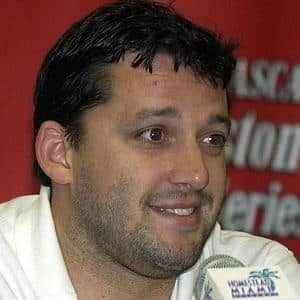Tony Stewart: The Motor Sport Interview
‘Smoke’ is one of America’s most-decorated drivers. Tony Stewart talks swapping seats with Lewis Hamilton, shunning the media spotlight and tackling the dragstrip
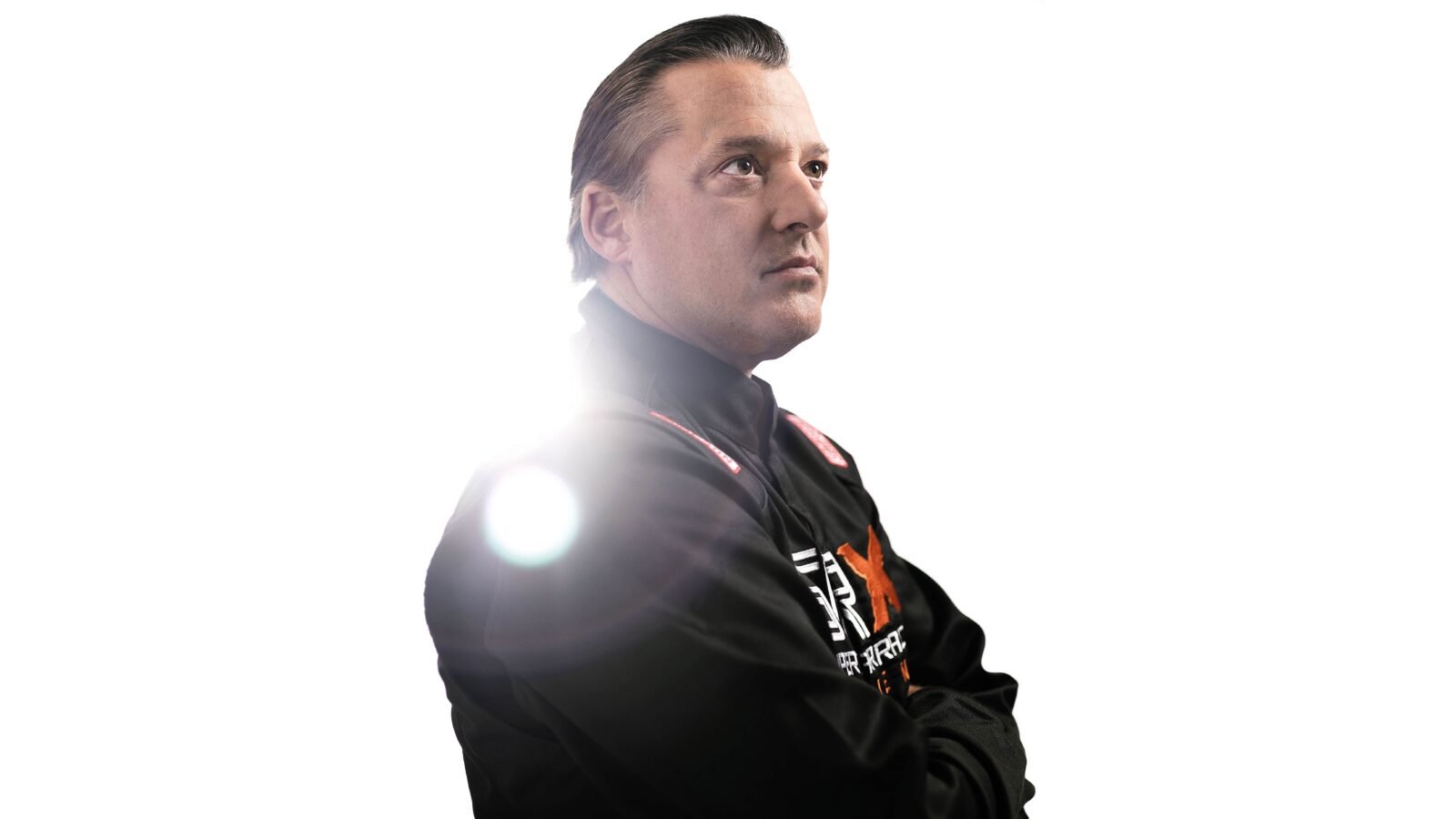
Getty Images
Tony Stewart is a legendary figure in his homeland, the only man to have won championships in both IndyCar and NASCAR. Nicknamed ‘Smoke’, he’s also won championships in midgets, sprints and USAC Silver Crown cars during a career that began in karts in 1980.
The statistics are phenomenal, a roll call of races and titles won in almost every category in the history of motor sport in North America. This year, despite saying he’s “semi-retired”, he’s on the NHRA dragstrips where he’s already collected more silverware. The veteran racer is also a philanthropist, the Tony Stewart Foundation supporting the plight of sick children among other causes.
There’s a dark side to Stewart’s career too, most notably the death of sprint car driver Kevin Ward Jr, hit by the guesting NASCAR star at the Canandaigu dirt track in 2014 when the 20-year-old had left his crashed car to remonstrate over a collision. Stewart was never charged or officially blamed for the incident.
The 53-year-old is known for his reluctance to put himself in the media spotlight, preferring to let the driving do the talking. From his ranch in Indiana, however, he speaks about his career as both driver and team owner, decades that have put him firmly in America’s Hall of Fame.

Racing at Phoenix in the ’93 USAC Silver Crown
Getty Images
Motor Sport: Let’s start in the present and work our way back. This year you’re doing NHRA top fuel dragsters. Why?
TS: Why not do something different? It’s a new challenge. It was never part of the plan, never a goal, but my career path over the last 47 years is unique, especially in this day and age of motor sport in America. I used to watch drag racing on TV in the evenings at sprint car races while we were waiting for the racing to start. When I met my wife Leah [Pruett] she was racing top fuel for Don Schumacher. When I got up close and personal with the sport in 2020 I realised how cool it was. As a driver I reckoned I knew what it would feel like but sitting in a debrief with her crew chief I was just the ‘trophy wife’ trying not to get in the way. Long story short, next step I was going to Frank Hawley’s Drag Racing School and by the end of the second day in a top alcohol dragster I realised how much is involved in the procedures.
“People watching thought I was going to crash on every lap”
I thought it was just a matter of firing up the engine, the engine tuner twists some screws, you do the burn-out, wind up, and off you go. You have 20 different things to do and I was having trouble with so many procedures. I said, “Frank, tell me the most important five.” In the second test I did 10 runs, it started to go right and I thought, “OK, that’s as far as it goes.” But it wasn’t. Don Schumacher gave me some runs in a top fuel car, that’s 300mph, whole different thing, it’s insane, but Leah thought I was ready and she wouldn’t have let me go ahead if she had any doubts. I thought it was the dumbest thing I’d ever done, a ridiculous decision, but fast-forward three years and here I am ready to race.
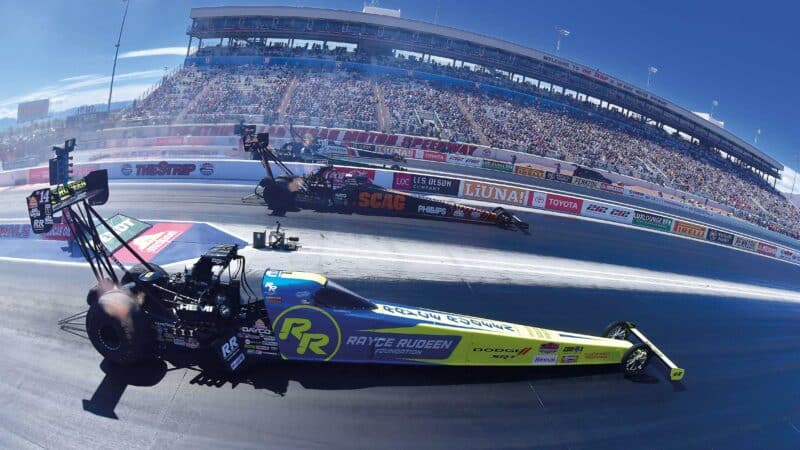
A recent switch to drag racing has once again taken Tony Stewart, nearest, out of his comfort zone
Getty Images
How were you drawn into motor sport?
TS: I went kart racing with my father when I was eight years old and I raced karts for 10 years. I really enjoyed that, a ton of life lessons learnt. Then it was three-quarter midgets in Indiana and it was Mark Dismore, for whom I’d raced karts, that gave me the big break into midgets and sprint cars on pavement tracks. The more races we won the word of mouth in Indiana just kept growing, I was more and more visible and the opportunities kept coming, in good cars and bad cars. You can’t always get the best at that stage.
There were ups and downs, but by 1993 I felt comfortable, knew I could do this, and in USAC I was finally able to support myself as a full-time race driver. I was getting opportunities, not six figures yet, not getting rich, but I could pay the rent, buy the groceries, pay the electric bill. On the way up you don’t know what you don’t know, you take the opportunities, and you get to drive the good cars.
You won the IRL championship in the early days of that series. Did that feel like a step up?
TS: Yeah, and a drastic one at that. My first race, at Disneyworld in ’96, that was sketchy. All through practice it was smooth, went well, then all of a sudden on race day it was really hot. There was low grip, we were running a ’95 Lola with a turbocharged Buick V6, so managing the power was crucial and I’d never driven a turbo. When the pace was fast the boost and the lag was minimal but when we had to slow down you’d get this big boost of power and the car got really loose. People watching told me they thought I was going to crash on every lap, so I was lucky to get through and finish second. I enjoyed IRL. It gave me the chance to go to IndyCar at the right time in my career.
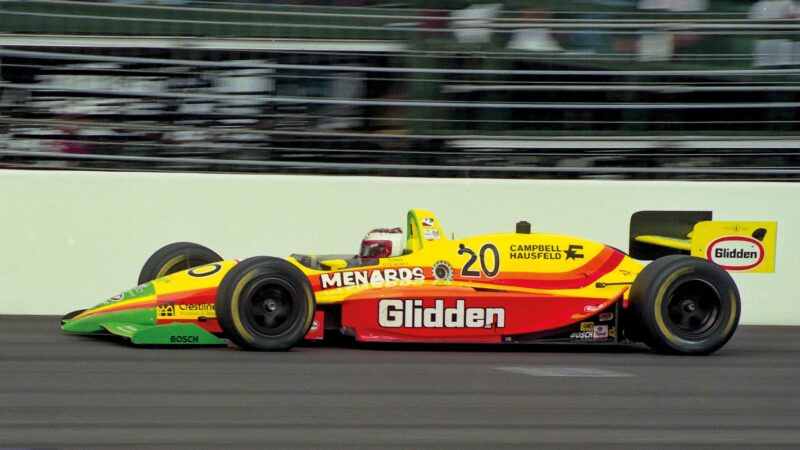
IndyCar debut at ‘The Mickyard’ (Walt Disney World Speedway), 1996.
Getty Images
Just as you were making a big name for yourself you went to NASCAR. Why was that?
TS: You’re probably expecting a very technical answer, but it was real simple: the IRL had 11 races and NASCAR had 33 races. So I got to race more. Nobody was sure about the future of IRL back then while NASCAR was going through the biggest growth spurt it had ever seen. It turned out to be the right move. Racing for the Joe Gibbs team in the Busch Series I learnt so many lessons. He was a great guy, a football coach, a car owner in NHRA, and they had Bobby Labonte, with a second car for me. I learnt more there than any other time in my career. They were there for just one reason, to win races and to win championships and it was a top-notch organisation, a unique opportunity.
What’s the skill of winning in NASCAR, the trick that puts you out front?
TS: It’s understanding how to see the air. That’s what Dale Earnhardt could do. He could tell where the air was, where the low pockets were. I bought an open-face helmet, to feel the air, but they banned them in the Cup cars two weeks before I had the chance to run it. Dale said he could feel the air pressure on his face, that’s how he found those pockets to maximise what he was doing with the car. Imagine you’re driving down a three-lane interstate, everyone is going the same speed, say 75mph, and you’re stacked, 3ft behind the car in front, 3ft from the car behind you, left and right there are cars less than 5ft away. On the track you’re doing 200mph, they’re less than 5ft away, and as soon as someone gets pushed, changes direction, they get turned and there’s trouble. Restrictor plate racing is a skill set in itself, different from anything else you do in NASCAR.
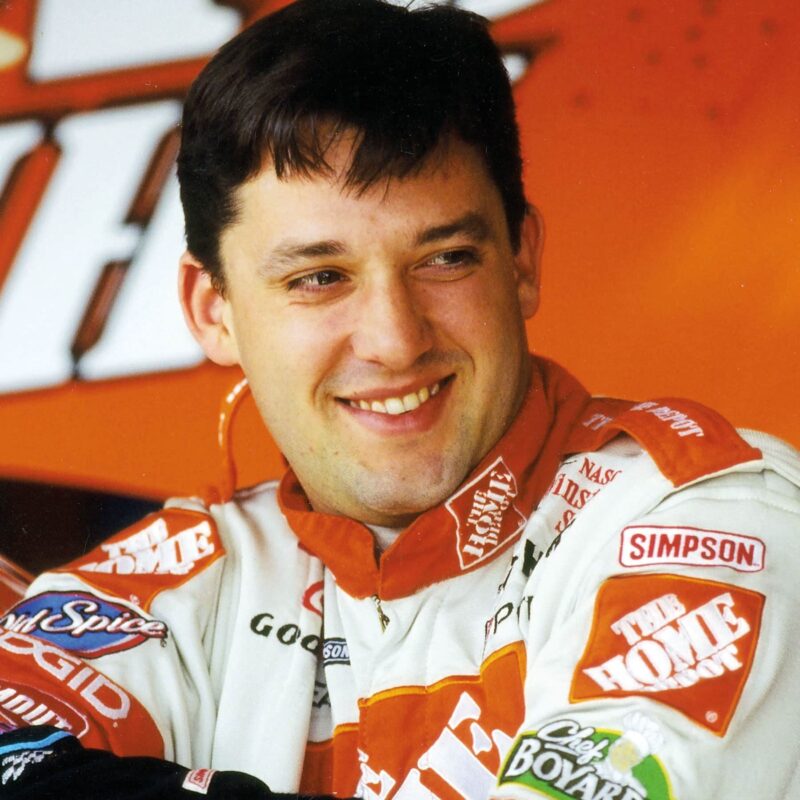
While Stewart was winning races and championships, he struggled with media attention
You won two Cup championships with Gibbs, in 2002 and ’05. Was there anything else to learn from the other top guys?
TS: The sport is constantly evolving. You are constantly learning. When you reckon you’ve got it all figured out something new comes down the line. I learnt from some great drivers at that time, a lot of them older than me, and then there were the younger ones like Jeff Gordon and Jimmie Johnson. Every generation raises the bar and there are so many variables. You keep growing your data base, just like in the rest of our lives. There’s so much more than looking at the stopwatch and thinking, “Those are good laps, I’ll keep doing it this way.”
You were famous nationwide, in the glare of the spotlight. Did you enjoy that side?
TS: No, I did not, I really didn’t. I was just a southern Indiana kid. I still live 15 minutes away from the house I grew up in. So, I really struggled with the attention, especially when I started winning in NASCAR. It wasn’t just at the track but away from the races as well. I wasn’t prepared for the effect it would have on me. It was not an easy transition. I felt there should be a distinction between what we did at the track and our private lives while I was away from the races. There’s all this hustle and bustle at the races, the bands, the fans, and when you get away you just want to have a peaceful normal life that everyone else has seven days a week. That became very difficult, everyone knew me from IndyCar, from NASCAR, from a bunch of different genres, and I was still moonlighting, running dirt tracks. It was crazy, and I really didn’t like all that.
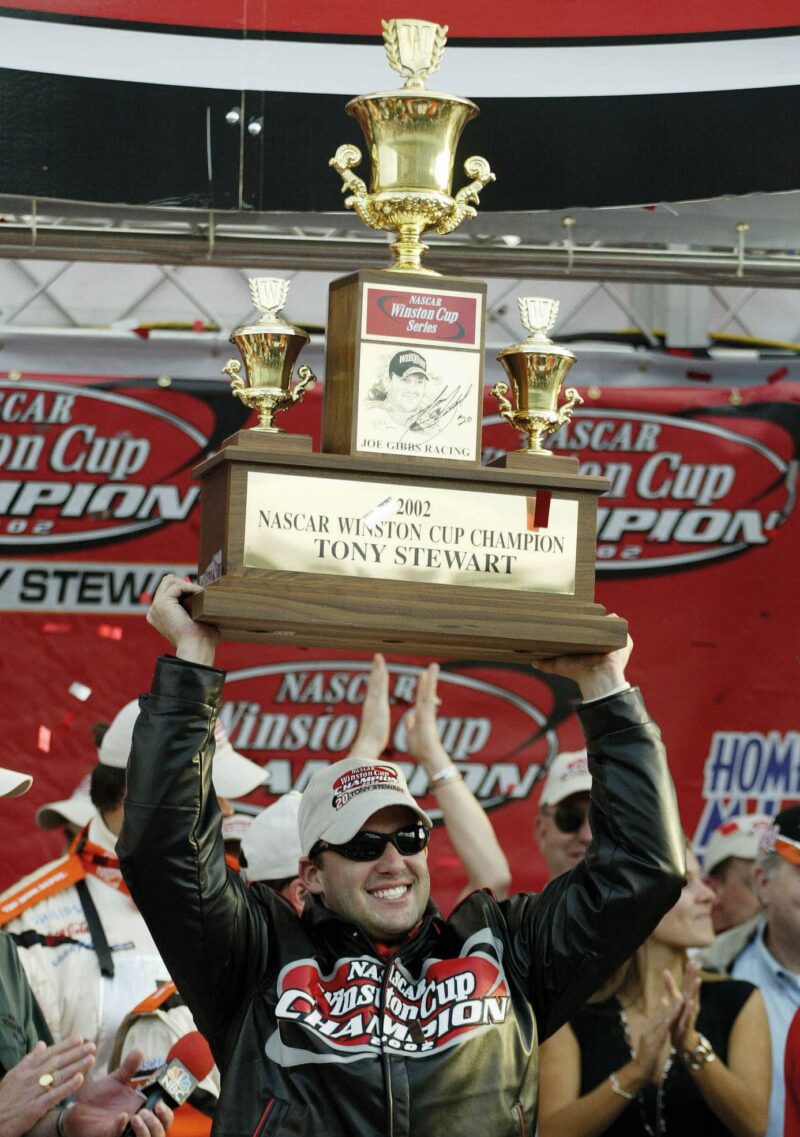
Clockwise from left: hoisting NASCAR’s hefty 2002 Cup trophy
Getty Images
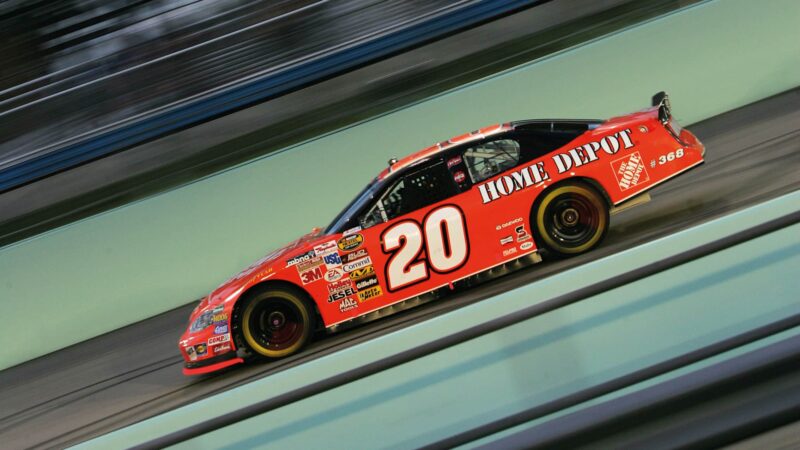
Stewart winning the NASCAR Cup Series at Homestead, Florida, 2005
Getty Images
You won on ovals, road courses and dirt tracks. Which did you find the most rewarding?
TS: Dirt tracks. I enjoyed them more than anything because they’re constantly changing. You have to be able to walk up the track, see what it’s going to be like after a couple of events and how much it’s going to change during a 30-lap race. Do you need to set-up for the bottom, where you’ll be a lot tighter, to get the car stuck? Or do you need to be bit freer so you can let the car run up to the cushion on the outside? The groove might change two or three times in 30 laps, you might start at the bottom, you might move up towards the outside, and you might go back to the bottom by the end. Being able to read the track like that during the race was an aspect I really enjoyed.
You became a NASCAR team owner with Gene Haas – which comes to an end in ’24 – when you stopped driving for Joe Gibbs. This must have put further pressure on you?
TS: Definitely, yeah. A lot more stress and responsibility went along with it but it was a great opportunity for me to have a future after driving. I did a year with Gibbs when they switched to Toyota. I had nothing against him and I learnt a lot from him about management, but an ownership opportunity doesn’t come along too often. Also, I wasn’t ready to retire as a driver – I mean I raced another seven years after the deal with Gene Haas.
When we won at Charlotte it was only our ninth race and the first time Haas had ever won a NASCAR Cup event. That made me feel good about my decision. And then, when I won the championship in 2011 and Kevin Harvick did so in 2014, we’d really made our mark.
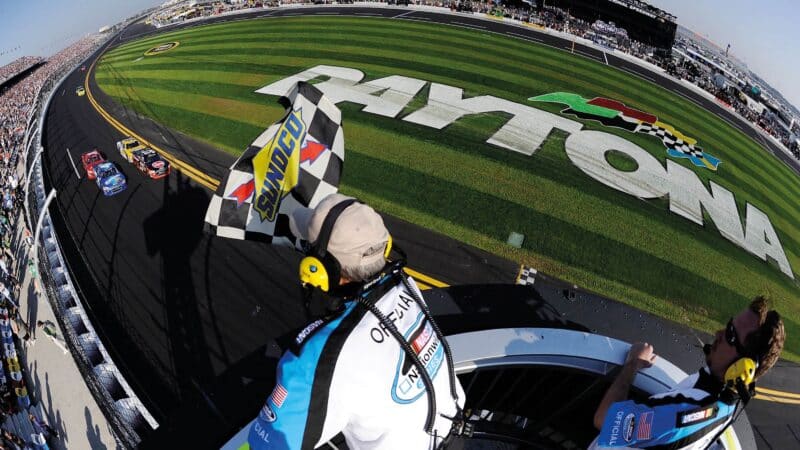
Edging to first place in the 2011 NASCAR Nationwide Series at Daytona
Getty Images
Not only did you become a team owner, you began to buy race tracks. How come?
TS: The Eldora Speedway, a clay dirt oval in Ohio, is the only one that I own 100%, the others are with partners. One morning, 9am, Earl Baltes, the Eldora owner, called me. I was still keeping sprint car driver hours, going to bed at 4am, getting up at 11am, so an early call from Earl, well, I have to pick it up. He says, “Hey, I need you to come talk to me,” and I say, “When?” And he says, “Now!” When Earl says jump, you say “How high?” I tell him I’d just woken up, fastest I can be there is four hours, it’s a three-hour drive from Indiana.
He’s waiting for me at the entrance, we walk in, sit down in the stands by the front stretch, looking out across this fantastic place. I’m thinking, “What am I doing here? Have I made him mad at me, something I did last time I raced here?” Anyway, he tells me his health is declining, his wife is stressed, and they’ve decided I’m the right guy to take the race track over. You know, it was like how I made it into IndyCar or NASCAR, none of it ever in the master plan, just be the best, be in the moment, take the right opportunities when they come. Eldora is a great facility. I knew it well. How could I say no to Earl Baltes? There’s a lot of things I don’t remember. That’s what hitting concrete walls does to you over the years. But I sure do remember that day.
You swapped cars with Lewis Hamilton for a day when he was at McLaren.
TS: Yeah, this was through our mutual partnership with Mobil 1. They did a similar thing with Jeff Gordon and Williams on the Indy road course. They asked me if I’d be interested. I said, “Am I interested? Get me in there, I’ve been waiting for this call.” To do this with Lewis Hamilton was amazing. He is absolutely an amazing person. His racing record speaks for itself but to talk to him without media, without cameras, was such a great opportunity. I loved racing on road courses. Sonoma was good for me, and even better success came at Watkins Glen – and that’s where we went. They literally took the seat scan I had in the Cup car and adapted it to the McLaren with their own inserts. Man, the detail, it was crazy. The only thing we changed was the heel rest on the throttle pedal side – a quarter of an inch. The belts were perfect, everything perfect.
“I would not like Formula 1. No need for you to speculate on this one”
The hard part was it rained, the track totally saturated, still drizzling in the morning. I did not have much experience in the rain, just in karts and in the Daytona 24, that was it. I’d never run the new section either, it wasn’t part of the NASCAR layout, but my friends at iRacing got me the track on the computer and I did two hours in an F1 car, just laps and laps and laps, then I flew to the Glen. We’d never run the Cup car in the rain but we went out and when we swapped cars the track was nearly dry. Lewis went five seconds faster than me in my car, and I went eight seconds faster than him in his car… on wet tyres. But, hey, he had nothing to prove and we laughed about it later. The conditions obviously played a part. It was such a cool day, some of the coolest laps I ever had in my life.
Somehow it’s difficult to picture you in Formula 1. Did you ever want to go there after so much success in America?
TS: No. I promise you. I would not like Formula 1. No need for you to speculate on this one. I watch it on TV though, and the braking zones are so damn short, maybe that’s why they crash while trying to overtake. In NASCAR the braking zones, with heavier cars and smaller tyres, are a lot longer. An F1 car is just as long as a stock car but the braking zone is less than half what we have, so you have to make that distance up in half the time. Look, I have huge respect for the drivers, but I would not enjoy F1 racing like I do in the types of racing we have over here. In the prime of my career maybe I would have jumped at the opportunity, I may have loved it, I don’t know. Where I’m at now, I’m a fan, and yeah, I would have enjoyed driving the cars, but not the racing part of it.
In 1999 and 2001 you raced both the Coca-Cola 600 and Indy 500 on one day! That sounds like hard work.
TS: You bet it’s hard work. It takes a toll on your body, a lot of travel, late nights, early mornings. I didn’t realise how tough it would be. As you know I’m not somebody you’re gonna see on the front cover of Men’s Health or GQ magazines. I wasn’t a big work-out guy and I’m still not. That’s not my thing. The second time I had a trainer from the Carolina Panthers. He was in control of everything I put in my mouth. I lost weight and I stuck to it, remembering how I felt after the first time I did those two races. At Indy we led for a while but we gambled on the cautions and got caught out by that in the end. At Charlotte I came third in the Coke 600, the only driver in history to complete the full 1100 miles. You have to be a little bit crazy to do what we do, but you only get one trip in this life. You can either take risks, try things people say you can’t do or you take the conservative route. I’m happy to have done more at 53 than some people have done when they get to 80 or 90 years old.
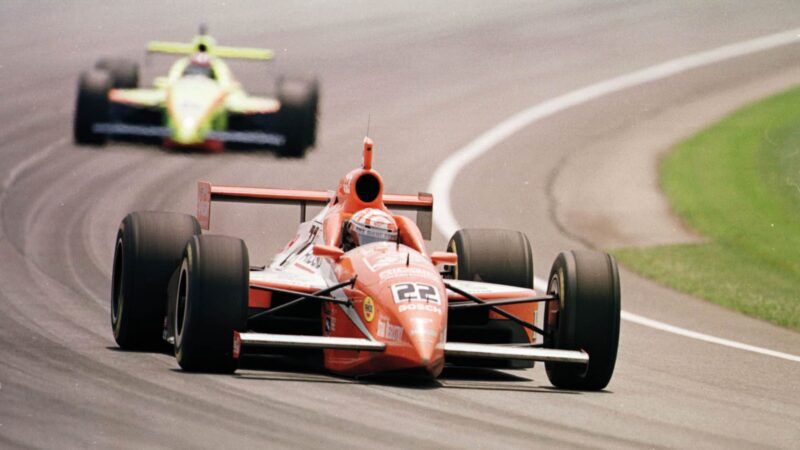
Indy 500/Coca-Cola 600 ‘double duty’ in 1999 – straight after racing here at The Brickyard, Stewart flew to Charlotte.
Your success has meant you can put something back with your Tony Stewart Foundation. Tell us a bit about that.
TS: I give NASCAR the credit for this. Most of the drivers had foundations but I never thought I’d be in that position. We help sick children. I love children, I love animals – I like dogs way better than most people, so we help those kind of charities that need support for many different reasons. I just wish I had more time to devote to it all. I remember what it was like not to have money for insurance policies, stuff like that, so being able to support people through the foundation is something I’m very proud of.
People often compare you to AJ Foyt, who’s known to shoot from the hip.
TS: I am honoured. AJ is my hero. You probably won’t find anyone in motor sport whose path replicates AJ’s more than mine. It wasn’t intentional, it was all about the opportunities I had. That’s why he’s my hero. When I got to midgets I also dabbled in dirt modified cars, ran a kart race here and there, a three-quarter midget race. In this era drivers simply cannot do that. They get so dedicated to one form of motor sport. I made it OK for drivers to go outside the box. Team owners don’t like it, and rightfully so, but I just wanted to race. Ever since I was little kid all I wanted to do was go to the races. There’s not a form of racing that
I don’t like. As long as it has wheels and a motor I love it. AJ could win in anything, whatever he drove. To be compared with him, I don’t think there is any higher honour than that.
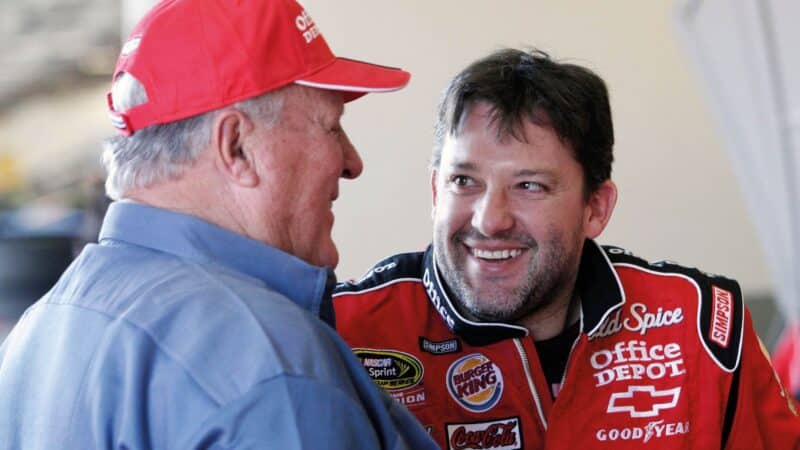
With hero AJ Foyt, also in 2009, at Daytona
Alamy
How did you get the nickname ‘Smoke’?
TS: It wasn’t a compliment. I got it racing for my first ever sprint car team. The motor configuration had the feel of a turbo, a flat spot in the power curve, and so when the motor ‘caught up’ you got more than you were asking for. So the tyres would slip on the pavement and that caused a little haze of smoke. The guys gave me a hard time about slipping the tyres, and the smoke it made, so that’s how it came about. Now I’m going drag racing you don’t want smoke in any circumstances. If they call you ‘Smoke’ there it’s not a good thing.
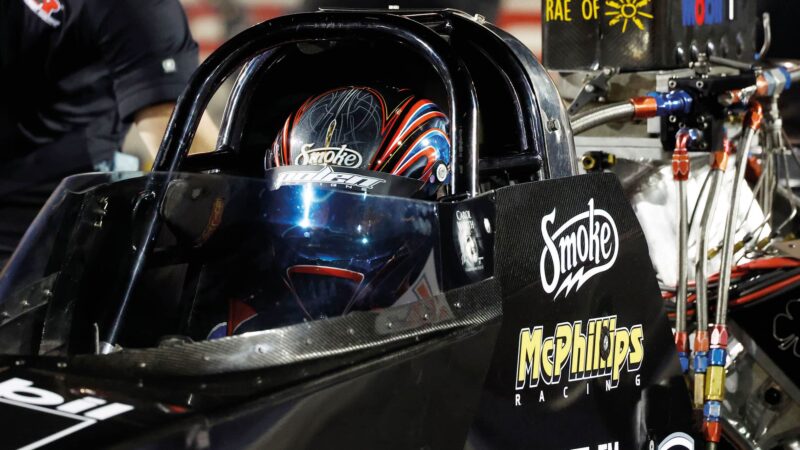
Smoke – the dragster ‘rookie’
Getty Images
Do you have any regrets when you look back over your 47 years on the track?
TS: I don’t have any. It was always a lot easier to ask for forgiveness than permission. I’m glad I took chances, like I’m not sure the dragsters are a good idea. But I’m doing it for my wife who’s stepping away from driving to start a family and that’s a monumental step in how it affects her career. It was never in the playbook but we take risks, we always have, and we’re gonna dive headfirst into it and we’re gonna figure it out. I love a challenge, not being comfortable, so I’ll do the top fuel dragsters and I don’t regret any of my career decisions.
Earlier you said you thought you knew what a top fuel dragster would feel like. So put us in your seat…
TS: It’s insanity. I’ve always done rolling starts, when your eyes are straight ahead. You get into a dragster and you’re looking up to the right, or up to the left, depending on your lane. You’re reacting to the lights, hitting the gas, and your eyes have to shift over and focus on where you’re at. I struggled with that in the school car. I was 100ft down the track before my eyes caught up to where I was. My brain was at the lights. I’m thinking, “What just happened?” The top fuel car was the only time in racing that my brain had to catch up. It’s a new application for the brain. It has to learn this procedure.
To be compared with AJ Foyt, there is no higher honour”
The acceleration is absolutely insane. Mike Salinas has the record of reaching 300mph in one eighth of a mile. You get to the end of the track and it’s 330mph and now you gotta stop. My crew chief asked me, “What’s it like when the chutes come out?” And I said, “Relief.” He was dying laughing, he’d never heard a driver say that. When the chutes come out you realise you’ve got a shot at getting stopped, you’re not going to sit there and drive right on through all the stuff at the finish line. You really have to drive it all the way. The tyres are in a constant controlled slip, not spinning, but it slips all the way – you’re never in a dead straight line.
The driver’s job is to cut a good light and keep it in the groove. There’s a lot to do in a very short time. What’s the difference between this and, say, NASCAR? My wife says everything us NASCAR drivers do in three and a half hours dragster racers do that in three and a half seconds. That’s just brilliant. You have to be on top of these cars, you have to react so fast, split-second decisions, at a higher level than any other car I’ve ever driven. You either get it right and you move on or you’re packing your bags for the next event. I’ll be going for Rookie of the Year this year.
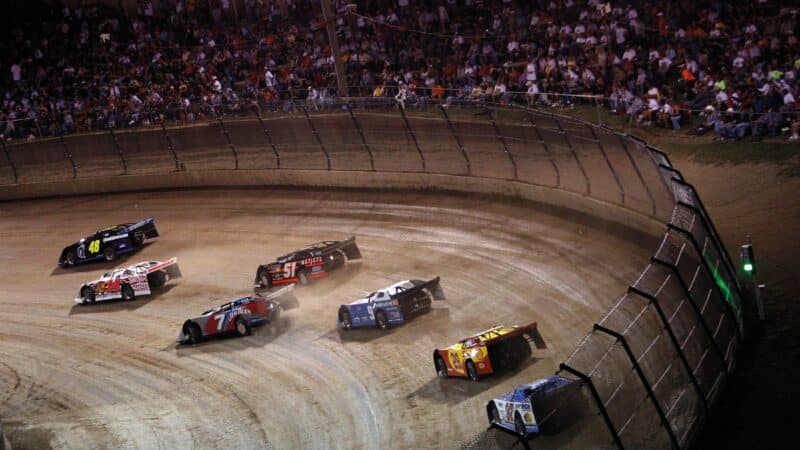
Jimmie Johnson leads Stewart at Eldora in 2009 – a track Stewart now owns.
Getty Images
Despite winning so many races and championships you have a fairly low profile in Europe. People say you don’t like all the media attention that success brings.
TS: Well, they’re wrong. The big misconception is that I don’t like the race fans and that I despise the media. People I’ve never met before tell me they don’t like me. Do I like that? No, I don’t. They’ve just seen moments at the races where I got frustrated and, yeah I did, because I learnt my NASCAR etiquette from Dale Earnhardt Sr, Jeff Gordon, Bobby Labonte, Rusty Wallace, all the greats from the Cup Series.
When you got there you were taught how to do things on track and that etiquette went away when the veterans started retiring. The game changed because the competition changed, and the technology, the way we raced changed, but I wanted it done the right way. Nobody likes to lose, but if I get beat by someone who does a better job, I’m not mad at that. When you’re beaten by guys who don’t play the rules, and you get crashed by stupid moves, then, yes, I get angry and frustrated. I got very frustrated by the media too, at least with about 5% of them, not all of them, and I have friends who are journalists, photographers.
I know who I am, that’s what matters, I don’t care what people think about me these days. Just don’t judge a book by its cover. At Thanksgiving some high-school friends and I went to a local bar, two guys came in wearing NASCAR shirts, not my shirts. They saw me and if looks could kill… They didn’t have to say anything. I walked over, I said I can see the looks, come over, have a beer, shoot some pool. Well, in southern Indiana you offer someone a beer, they’re gonna take it. I said, “Stay half an hour, drink all the beer you can, no problem.” They stayed until closing time, told me they never thought I was like that. I said, “Fine, when you came in you didn’t know me, you based how you felt on what you’ve heard about me.” Every generation thinks they know it all. Opinions… everybody’s got one, but if I tell my friends my politics, for example, I’ll likely lose half of them.
Man, I’m just a race driver. I never chased popularity, and when negative things happen there’s always positives that come out of that.
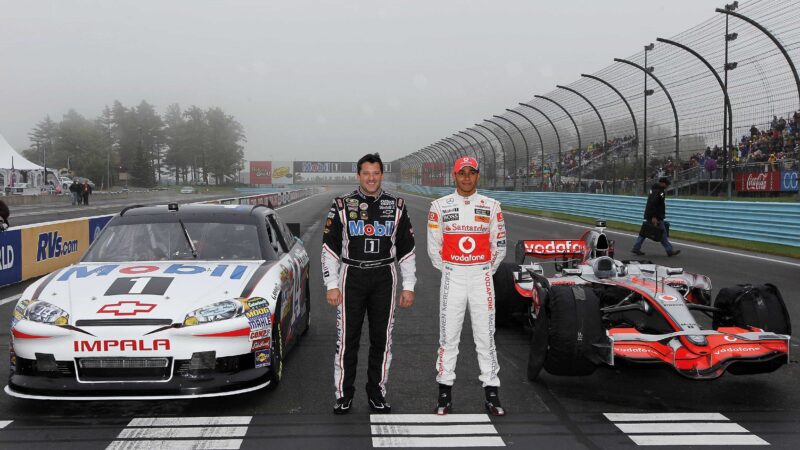
Car share: Stewart with McLaren’s Lewis Hamilton in 2011 – the weather did its best to hijack the proceedings
